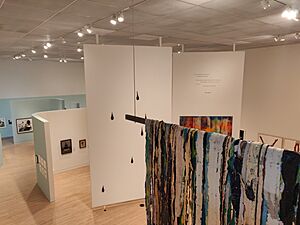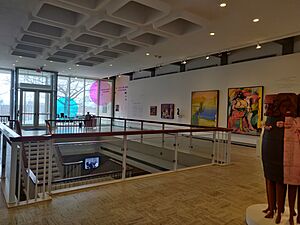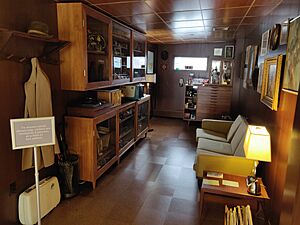Rose Art Museum facts for kids
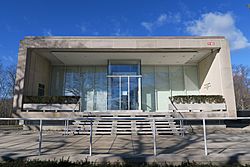 |
|
| Established | 1961 |
|---|---|
| Location | Waltham, Massachusetts, US |
| Type | Art museum |
| Collection size | 9,000 |
| Visitors | 13,000 |
| Architect | Harrison & Abramovitz (1961, 1974) |
| Owner | Brandeis University |
| Public transit access | MBTA Brandeis/Roberts |
The Rose Art Museum is a cool art museum that opened in 1961. It's part of Brandeis University in Waltham, Massachusetts, USA. The museum is named after Edward and Bertha Rose, who were very generous supporters. It shows off amazing art from its huge collection of 9,000 pieces. The Rose Art Museum has one of the biggest collections of modern and contemporary art in all of New England. Since it first opened, the museum has been known for being super creative and always looking for new ideas in art.
Contents
Building the Museum: Architecture and Design
The Rose Art Museum building was designed by a company called Harrison & Abramovitz. It's a simple, geometric shape. When it first opened in 1961, it had about 12,000 square feet (1,100 square meters) of space for art. This wasn't very big, and soon the museum's art collection grew too large for the building.
So, in 1974, the museum added more space. Now, it has about 13,000 square feet (1,200 square meters) of exhibition space across three galleries. The Rose Art Museum usually puts on 9 to 12 art shows each year. Most of these shows are put together by the museum's own team.
Light of Reason Sculpture
Right in front of the museum, you'll see a cool outdoor sculpture called Light of Reason by Chris Burden. This artwork was put in place in 2014. It has three rows of 24 old-fashioned lamp posts that spread out around the museum's entrance. The sculpture acts like a special gateway and a place for outdoor events. It has become a famous landmark on the university campus.
History of the Rose Art Museum
How the Museum Started
Even before Brandeis University had its first graduating class in 1951, the university already owned more than 300 paintings. These included works by famous artists like Stuart Davis, Fernand Léger, and Milton Avery.
Sam Hunter was the first director of the Rose Art Museum. He came to Brandeis from the Museum of Modern Art in New York City. With a special gift of $50,000, he started the museum's collection. He bought important artworks by artists like Jasper Johns, Robert Rauschenberg, Andy Warhol, and Willem de Kooning. The museum has always focused on showing art by leading contemporary artists. Many of these artists, like Frank Stella, Kiki Smith, and Nam June Paik, had their first museum shows at the Rose. This is why the Rose Art Museum has one of the best collections of modern and contemporary art in New England.
Big newspapers like The New York Times noticed the important shows at the museum. They praised a show by David von Schlegell in 1968 and called a 1969 sculpture exhibit by James Rosatti "an event of some importance." In 1970, the museum showed Vision & Television, which was the very first video art exhibition in the United States.
Challenges: Selling Artworks (1991)
In 1991, Brandeis University announced a plan to sell fourteen artworks from the Rose Art Museum. These included pieces by famous artists like Renoir and Toulouse-Lautrec. This plan caused a lot of strong disagreement. Many people in the art world were upset. For example, Arnold L. Lehman, who led a group of museum directors, said it was "like selling one of your children to feed the others."
People believed that if a museum sells art, the money should only be used to buy more art, not for other things. However, on November 6, 1991, eleven artworks were sold at an auction. The university said the money would be used to help pay for new art, education, and taking care of the collection.
Challenges: Plans to Close (2009-2011)
On January 26, 2009, the president of Brandeis University announced plans to close the museum. This was a big surprise and happened because of money problems during a financial crisis. The university said it was a "hard decision" but that students and teaching had to come first.
Many people, including the museum's director and art experts, strongly disagreed with the plan. They said it would go against the wishes of the people who had donated art to the museum. Some of the museum's supporters even filed a lawsuit to stop the closing and the sale of the artworks. They argued that the museum was meant to stay open forever.
The museum's director at the time, Michael Rush, was very surprised by the news. He helped organize people who were against the closing. Even though his job at Brandeis ended, he later became the founding director of a new art museum at Michigan State University.
The situation was difficult for a long time. The museum stayed open but didn't start many new programs because it didn't have a permanent director. Finally, by June 30, 2011, a new university president helped settle the lawsuit. The Rose Art Museum stayed open, and no artworks were sold to support the university's other operations. This whole story was even written about in a book called Cashing in on Culture: Betraying the Trust at the Rose Art Museum.
Reopening and Anniversaries
After a short time closed for important updates, the Rose Art Museum reopened on October 25, 2011. This was a special event because it was also the museum's 50th anniversary! There were celebrations and speeches by the university president and the artist James Rosenquist.
After closing temporarily in March 2020 because of the COVID-19 pandemic, the museum first reopened to Brandeis University students and staff in September 2020. It was one of the first university art galleries in the Boston area to open its doors to the public again, which happened on June 25, 2021.
On December 15, 2021, Gannit Ankori, a well-known art historian, became the new Director and Chief Curator of the museum. To celebrate the museum's 60th anniversary, the Rose created a special exhibition called re:collections. This show featured artworks that changed over three years. It put less-known artists next to famous ones to share new voices and make art history more fair.
Art Collections
The Rose Art Museum has more than 9,000 pieces of art. This includes works by amazing artists like Mark Bradford, Judy Chicago, Cindy Sherman, Helen Frankenthaler, Paul Gauguin, Yayoi Kusama, Henri Matisse, Jasper Johns, Roy Lichtenstein, Pablo Picasso, Henri de Toulouse-Lautrec, and Andy Warhol.
Digital Collection
In 2014, the Rose Art Museum started a digital archive of its large modern and contemporary art collection. This means you can now explore many of their artworks online! This project was supported by special grants and helps people learn about the museum's artists, new art pieces, and past exhibitions.
The Undisciplined Collector
In 2015, the artist Mark Dion created a permanent art installation called The Undisciplined Collector. It's in a small gallery on the ground floor of the museum. This room-sized artwork looks like a "den" (a cozy living room) from 1961. It's like a wunderkammer (a cabinet of curiosities) or a time capsule filled with real objects from that time. These items came from different collections at Brandeis University.
The year 1961 was important because it was when both the artist and the museum were born. Some of the things in the room show news about the museum's opening. You can see old record albums, magazines, small sculptures, trophies, and souvenirs.
Visitors can actually go inside this art installation to look closely at everything. You can even relax on the sofa, which looks just like furniture from the 1960s. There's a small booklet that tells the story of the Rose Art Museum and where some of the items came from.
Important Exhibitions
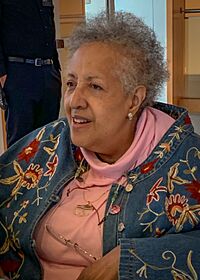
- A Century of Modern European Painting, the very first show, June 3 – September 15, 1961
- Vision & Television, the first video art exhibition in the United States, January 21 – February 23, 1970
- Vasily Kandinsky, May 1 - June 7, 1974
- More Than Minimal: Feminism and Abstraction in the '70s, April 21 - June 30, 1996
- Pretty Raw: After and Around Helen Frankenthaler, February 11 - June 7, 2015
Museum Directors
- Sam Hunter (1961–1965)
- William C. Seitz (1965–1971)
- Russell Connor (1971)
- Michael Wentworth (1971–1974)
- Carl Belz (1974–1998)
- Joshep D. Ketner (1998–2006)
- Michael Rush (2006–2009)
- Christopher Bedford (2012–2017)
- Luis Croquer (2017–2020)
- Gannit Ankori (2020–present)
See also
- Deaccessioning (museum)


